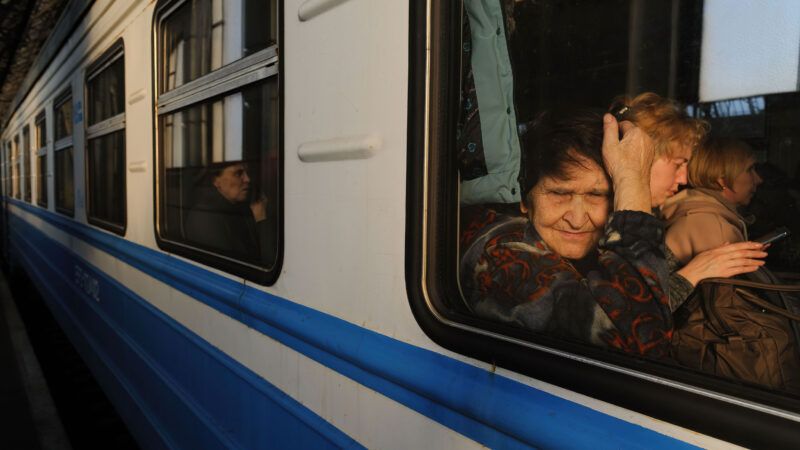The U.S. Only Resettled 12 Ukrainian Refugees Last Month
The U.S. has taken in more Ukrainians through other migration pathways, but the low refugee tally shows how ill-prepared the U.S. refugee resettlement program was to help Ukrainians.

On March 24, President Joe Biden announced that the United States would accept up to 100,000 displaced Ukrainians. The move came one month after Russian President Vladimir Putin launched a large-scale invasion of Ukraine, which has forced roughly 4.5 million people to flee the country to date.
Though the Biden administration's plan may seem like an appropriate response to the mounting migration crisis in Europe, there's no indication that the U.S. will be capable of processing that many fleeing Ukrainians. In March, just 12 Ukrainians came to the U.S. through the American refugee program.
That abysmal number highlights several key issues that stand in the way of the U.S. helping Ukrainians. First, the U.S. Refugee Admissions Program (USRAP) is ill-prepared to efficiently process any great number of Ukrainian refugees. Second, the Biden administration will be taking a patchwork approach to welcoming displaced Ukrainians to the U.S., including the use of nonimmigrant visas—and the exact components of that approach are not yet clear. Combined, these problems are keeping Ukrainians in limbo and complicating America's plans to accept those displaced by the conflict.
"So far in March, the U.S. has admitted a dozen Ukrainians as refugees," reported CBS News' Camilo Montoya-Galvez on March 25, "who were most likely all in the resettlement pipeline long before the Russian invasion, according to internal government data shared with CBS News."
The U.S. refugee resettlement program was already facing staggering backlogs before the conflict in Ukraine, meaning it never had a solid chance at offering quick relief to displaced Ukrainians. Prior to the Trump administration, it took somewhere between 18 and 24 months for refugees to complete the resettlement process. Though the exact post-COVID wait time for U.S. refugee processing is murky, those referred to the "Priority 1" pathway by the United Nations High Commissioner for Refugees face a wait between two and 10 years.
It's highly likely that conflict-related flight cancellations prevented many Ukrainian refugees cleared to travel to the U.S. from departing the country in March (according to Reuters, the U.S. took in 514 Ukrainian refugees in January and February). The State Department has indicated that refugee operations are now taking place in Chisinau, Moldova, rather than in the Ukrainian capital of Kyiv. "Lawmakers and advocates have urged the Biden administration to accelerate the processing of Ukrainian applications saying too little has been done so far," reports Reuters.
The Biden administration resettled just 11,411 refugees in the U.S. in FY 2021, short of an annual cap of 62,500. The pandemic severely hindered America's refugee processing—officials could not conduct in-person interviews, and key support facilities could not operate normally—and there has been lasting damage from the restrictive refugee policies imposed by the Trump administration. Biden has set the 2022 refugee cap at 125,000, even though he admitted last year that the "goal will still be hard to hit" and "we might not make it the first year."
The reality of refugee caps should indicate that the Biden administration's intention to accept 100,000 Ukrainians is a target, not a binding number. Another sticking point is that not all Ukrainians coming to the U.S. will be refugees in the technical sense of the word—that is, people outside the U.S. who demonstrate they have experienced persecution, are of special humanitarian concern to the United States, and are eligible to access the USRAP through one of three pathways.
Rather, the White House says it will rely on "the full range of legal pathways, including the U.S. Refugee Admissions Program," but perhaps also nonimmigrant options that do not confer the same benefits and logistical support as the USRAP. The Cato Institute's David J. Bier has cautioned that the Biden administration "may even count the 75,000 Ukrainians who will be granted Temporary Protected Status" and "were already in the United States at the time of the invasion" toward the 100,000 goal.
Faced with the slow-moving U.S. refugee program, Ukrainians are looking elsewhere for passage to America—including through the U.S.-Mexico border. Ukrainians do not need to secure a visa before traveling to Mexico (a requirement to enter the U.S.), meaning that thousands have elected to fly from Mexico City to Tijuana and try their luck at entering the U.S. on foot. Last week, the Department of Homeland Security confirmed that about 3,000 Ukrainians were permitted to cross into the U.S. from Mexico. In the past two months, border officials have processed almost 10,000 undocumented Ukrainians. (Critically, these are not refugees, since they did not secure refugee status while they were outside of the U.S.)
It's deeply disappointing that Ukrainians are being forced to navigate such a circuitous process to reach safety in the United States. Their struggle highlights how deeply unprepared the Biden administration was to properly address an emergent migrant crisis and how critical it is for the U.S. immigration system to process refugees and other Ukrainian newcomers with the sense of urgency they deserve.



Show Comments (52)